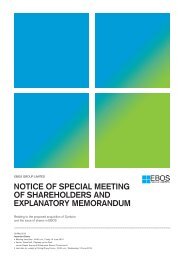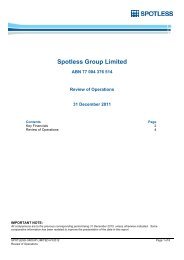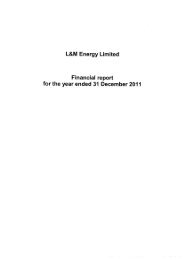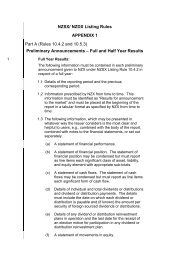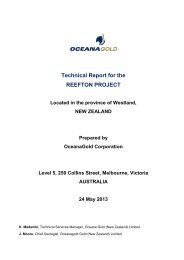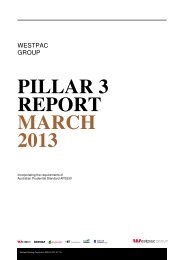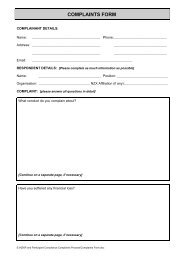New Image Annual Report 2012 concept.indd - NZX
New Image Annual Report 2012 concept.indd - NZX
New Image Annual Report 2012 concept.indd - NZX
Create successful ePaper yourself
Turn your PDF publications into a flip-book with our unique Google optimized e-Paper software.
Notes to and forming part of the financial<br />
statements (continued)<br />
For the year ended 30 June <strong>2012</strong><br />
30<br />
Inter-entity sales<br />
Inter-entity sales are recognised based on an<br />
internally set transfer price as set from time to<br />
time. This pricing aims to reflect what the<br />
business operation could achieve if they sold their<br />
output and services to external parties at arm’s<br />
length.<br />
Segment assets and liabilities<br />
Segment assets and liabilities are shown net of<br />
intra-group balances, as these are a function of<br />
operational cash management and funding<br />
arrangements intra-group, and are not regarded<br />
as a part of each segment’s operational balances,<br />
even though they may form part of a particular<br />
geographical entity’s financial position.<br />
Inter-segment reconciliations to Group totals<br />
For the Group, the total for all operating<br />
segments, adjusted by any inter-segment<br />
eliminations, equals the total reported for the<br />
entity. Inter-segment eliminations include intragroup<br />
sales, cost of sales, commissions,<br />
management services fees, and profit on stock<br />
still held at reporting date sold at intra-group<br />
transfer prices.<br />
Income tax expense<br />
Income tax expense is calculated based on the<br />
segment operating profit using a notional charge<br />
of 28% (2011: 30%), except for Malaysia which is<br />
at 25% (2011: 25%). Partial adjustment (shown<br />
wholly in the Head Office Segment) is given for<br />
taxable or deductible temporary differences as<br />
estimates only to get a total Group position.<br />
W <strong>New</strong> Accounting Standards and<br />
Interpretations<br />
i) Changes in Accounting Policy and Disclosures<br />
The accounting policies adopted are consistent<br />
with those of the previous financial year except<br />
as follows:<br />
The Group has adopted the following new and<br />
amended <strong>New</strong> Zealand Equivalents to Financial<br />
<strong>Report</strong>ing Standards and interpretations as of 1<br />
July 2011.<br />
NZ IAS 24 – Related Party Disclosures<br />
– effective 1 July 2011<br />
NZ IFRS 7 – Financial Instruments<br />
Disclosures – effective 1 July 2011<br />
NZ FRS 44 – <strong>New</strong> Zealand Additional<br />
Disclosures – effective 1 July 2011<br />
The Group has not elected to early adopt any<br />
new standards or interpretations that are issued<br />
but not yet effective.<br />
<strong>Annual</strong> Improvements Project [2009 - 2011]:<br />
In 2009 to 2011 various amendments to NZ IFRS<br />
were issued as part of the <strong>Annual</strong> Improvements<br />
Project, primarily with a view to removing<br />
inconsistencies and clarifying wording. There are<br />
separate transitional provisions and application<br />
dates for each amendment. The adoption of the<br />
amendments resulted in changes to accounting<br />
policies but did not have any impact on the<br />
financial position or performance of the Group.<br />
ii) Accounting Standards and Interpretations<br />
Issued but Not Yet Effective<br />
At the date of authorisation of these financial<br />
statements, the following Standards and<br />
Interpretations were in issue but not yet effective:<br />
NZ IAS 12 – Amendments to Income Taxes<br />
– effective for periods on or after 1 January<br />
<strong>2012</strong><br />
NZ IAS 1 – Amendments to Presentation of<br />
Financial Statements – effective for periods<br />
on or after 1 July <strong>2012</strong><br />
NZ IAS 19 – Employee Benefits – effective<br />
for periods on or after 1 January 2013<br />
NZ IAS 27 – Separate Financial Statements<br />
– effective for periods on or after 1 January<br />
2013<br />
NZ IAS 28 – Investments in Associates and<br />
Joint Ventures – effective for periods on or<br />
after 1 January 2013<br />
NZ IFRS 7 – Amendments to Financial<br />
Instruments: Disclosures – effective for<br />
periods on or after 1 January 2013<br />
NZ IFRS 10 – Consolidated Financial<br />
Statements – effective for periods on or<br />
after 1 January 2013<br />
NZ IFRS 11 – Joint Arrangements – effective<br />
for periods on or after 1 January 2013<br />
NZ IFRS 12 – Disclosure of Interests in Other<br />
Entities – effective for periods on or after 1<br />
January 2013<br />
NZ IFRS 13 – Fair Value Measurement<br />
– effective for periods on or after 1 January<br />
2013<br />
NZ IAS 32 – Amendments to Financial<br />
Instruments: Presentation – effective for<br />
periods on or after 1 January 2014<br />
NZ IFRS 9 (2010) – Financial Instruments<br />
– effective for periods on or after 1 January<br />
2015<br />
The directors expect that the standards and<br />
interpretations above may impact the Group in<br />
the next financial year. The directors have not yet<br />
made an assessment of the impact of these<br />
standards and interpretations. These standards<br />
and interpretations are likely to affect disclosure<br />
rather than measurement of transactions.<br />
All standards and interpretations will be adopted<br />
at their effective date (except for those<br />
Standards and Interpretations that are not<br />
applicable to the entity).<br />
X Investments in Associates<br />
The Group’s investment in its associates is<br />
accounted for using the equity method of<br />
accounting in the consolidated financial<br />
statements and at cost in the parent. The<br />
associates are entities over which the Group has<br />
significant influence and that are neither<br />
subsidiaries nor joint ventures.<br />
The Group generally deems it has significant<br />
influence if it has over 20% of the voting rights.<br />
Under the equity method, investments in<br />
associates are carried in the consolidated<br />
Statement of Financial Position at cost plus<br />
post-acquisition changes in the Group’s share of<br />
net assets of the associates. Goodwill relating to<br />
an associate is included in the carrying amount of<br />
the investment and is not amortised. After<br />
application of the equity method, the Group<br />
determines whether it is necessary to recognise<br />
any impairment loss with respect to the Group’s<br />
net investment in associates. Goodwill included in<br />
the carrying amount of the investment in<br />
associate is not tested separately, rather the<br />
entire carrying amount of the investment is<br />
tested for impairment as a single asset. If an<br />
impairment is recognised, the amount is not<br />
allocated to the goodwill of the associate.<br />
The Group’s share of associate’s profits or losses<br />
is recognised in the Statement of Comprehensive<br />
Income, and its share of movements in other<br />
comprehensive income is recognised in Other<br />
Comprehensive Income. The cumulative<br />
movements are adjusted against the carrying<br />
amount of the investment. Dividends receivable<br />
from associates are recognised in the parent<br />
entity’s Statement of Comprehensive Income as a<br />
component of other income.<br />
After application of the equity method, the<br />
Group determines whether it is necessary to<br />
recognise an additional impairment loss on the<br />
Group’s investment in its associate. The Group<br />
determines at each reporting date whether there<br />
is any objective evidence that the investment in<br />
the associate is impaired. If this is the case the<br />
Group calculates the amount of impairment as<br />
the difference between the recoverable amount<br />
of the associate and its carrying value and<br />
recognises the amount in the “share of profit of<br />
an associate” in the Statement of Comprehensive<br />
Income.<br />
31<br />
NEW IMAGE GROUP ANNUAL REPORT<br />
NEW IMAGE GROUP ANNUAL REPORT



